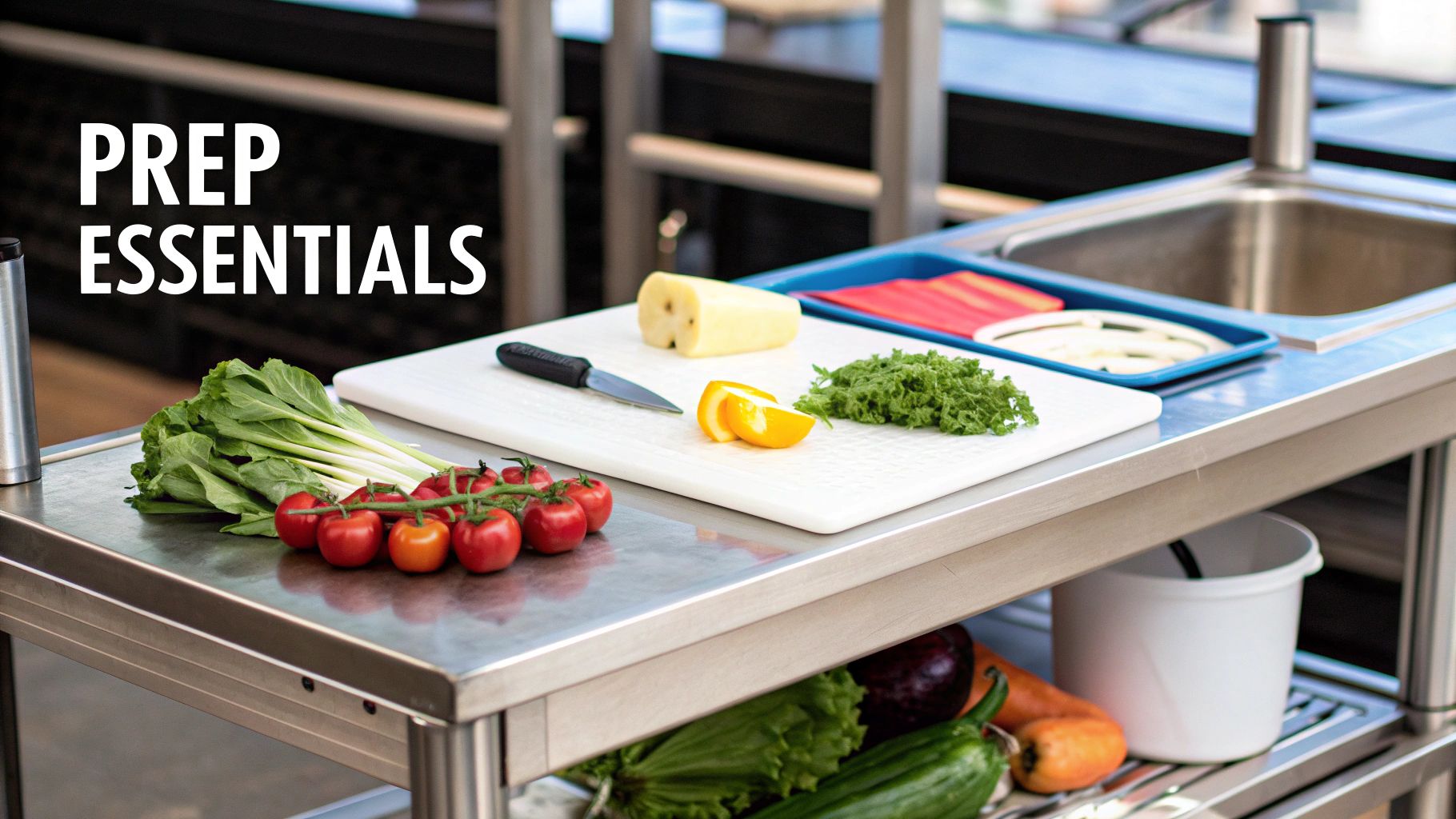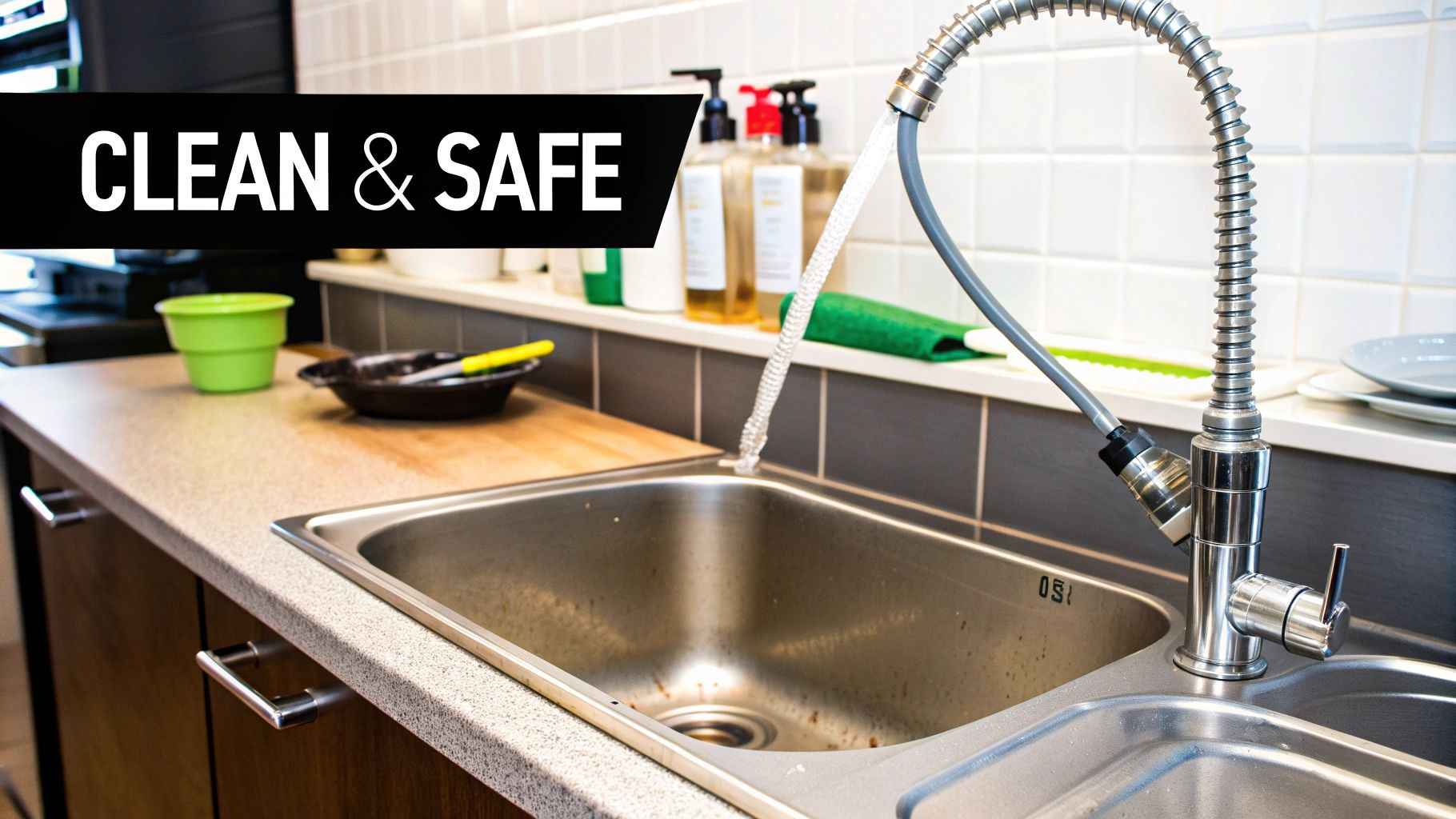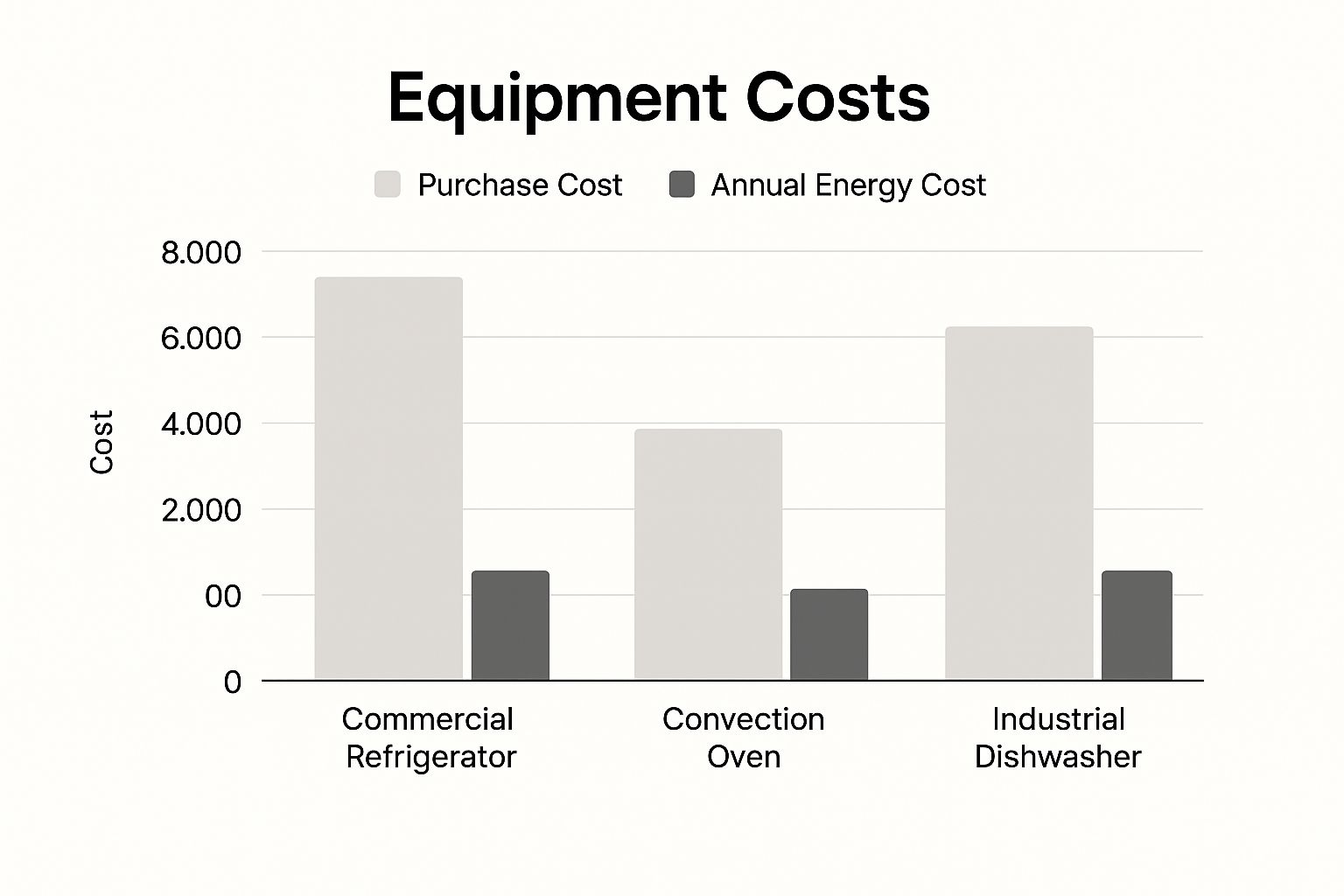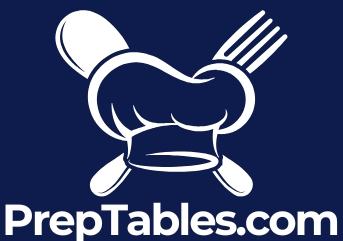
Your Guide to Commercial Kitchen Equipment
Share
Think of your commercial kitchen equipment as the backbone of your entire culinary operation. This guide is your map, helping you navigate everything from the workhorse cooking ranges and refrigerators to the essential prep tables and warewashing stations. We'll break down how to choose the right gear for your menu, making sure your kitchen is set up for speed, efficiency, and long-term success.

Understanding the Core Components of a Professional Kitchen
Putting together a commercial kitchen is so much more than just buying appliances. It’s about building a seamless system where every piece of equipment plays a specific, vital role. From the moment ingredients are delivered to the instant a finished plate goes out to a customer, your equipment sets the pace, quality, and safety for your whole operation.
A well-thought-out kitchen layout just makes life easier. It cuts down on chaos, reduces staff stress, and directly impacts your profitability. We're going beyond just listing specs to show you how each piece fits into the puzzle of a real, working kitchen. Whether you’re opening a buzzing restaurant, a small café, or a massive catering business, the right tools are non-negotiable.
Core Commercial Kitchen Equipment Categories at a Glance
Before diving into specifics, it's helpful to see how everything fits together. Every professional kitchen is built around a few fundamental categories of equipment, each handling a critical stage of the food production process.
| Equipment Category | Primary Function | Common Examples |
|---|---|---|
| Cooking Equipment | The heart of the kitchen; where raw ingredients are transformed into finished dishes. | Ranges, Ovens, Fryers, Grills, Griddles, Broilers |
| Refrigeration & Storage | Crucial for food safety, preserving ingredient quality, and controlling costs. | Walk-In Coolers, Reach-In Refrigerators, Freezers, Ice Machines |
| Preparation Equipment | Streamlines the initial steps of food production to maximize efficiency. | Prep Tables, Food Processors, Mixers, Slicers, Sinks |
| Warewashing | Essential for maintaining sanitation, health code compliance, and a smooth workflow. | 3-Compartment Sinks, Commercial Dishwashers, Drying Racks |
Understanding these core areas is the first real step in planning your kitchen's layout, workflow, and budget.
The demand for this kind of equipment is massive and still climbing. The global commercial cooking equipment market is a huge part of the foodservice world, expected to grow from USD 13.8 billion to USD 22.4 billion by 2033. This boom shows just how critical professional-grade tools are. You can get a better sense of these market projections and their impact on the foodservice industry to see where things are headed.
Why Professional Grade Matters
It might be tempting to look at residential appliances to save a few bucks upfront. Trust me, that's a huge mistake for any serious foodservice business. Commercial kitchen equipment is built from the ground up to take the constant punishment of a professional environment.
Professional equipment is built for volume, durability, and safety. Unlike its residential counterparts, it’s engineered with materials like heavy-gauge stainless steel to withstand constant use, extreme temperatures, and rigorous cleaning protocols required to meet health codes.
When you choose certified equipment, like gear approved by NSF International, you're ensuring it meets strict public health and safety standards. This doesn't just protect your customers; it helps you fly through health inspections without a hitch. Investing in the right commercial-grade equipment from day one will save you a world of headaches from costly repairs, potential fines, and operational shutdowns later on.
The Heart of the Operation: Core Cooking Equipment
If a commercial kitchen has a soul, it's the cooking line. This is the high-energy stage where raw ingredients become the dishes on your menu. It’s where everything comes together, powered by essential pieces of commercial kitchen equipment like ranges, ovens, fryers, and grills. Knowing what each piece does best is the first step to building a cooking station that just works.

Picking the right equipment isn't just about filling an empty space. It's a strategic move that directly affects your ticket times, the quality of your food, and even your monthly utility bills. The right combination of cooking power gives your team the tools they need to execute every dish perfectly and quickly, even in the middle of a chaotic dinner rush.
Ranges and Ovens: The Kitchen's Power Couple
Every professional kitchen is built around the classic workhorse: the commercial range and oven. Think of them as a team. The range top is for the immediate, fast-paced action—sautéing, searing, and simmering. Below, the oven provides the steady, all-around heat you need for roasting, baking, and holding.
Modern commercial ranges offer incredible flexibility. You might want open burners for that direct flame, a flat-top griddle for a busy breakfast service, or even an induction cooktop for pinpoint temperature control and better energy efficiency. The oven base can be just as specialized:
- Standard Ovens: Your go-to for general baking and roasting tasks. Reliable and straightforward.
- Convection Ovens: These use fans to move hot air around, which can cook food up to 25% faster and more evenly than a standard oven. They're a game-changer for high-volume bakeries or for getting that perfect, consistent roast on vegetables and proteins.
- Combi Ovens: These are the high-tech multitaskers. By combining steam, convection heat, or both, they give a chef total control over the cooking environment. You can steam, poach, roast, and bake, all in one incredibly versatile machine.
Fryers and Grills: Mastering Specialized Cooking
While ranges and ovens are the jack-of-all-trades, some menu items need a specialist. That’s where equipment like fryers and grills come in. Getting these pieces right is crucial for nailing the signature textures and flavors your customers crave.
A commercial deep fryer is a must-have for those perfectly golden-brown french fries, crispy chicken wings, or delicate tempura. They're built to get back to temperature fast, which is the secret to making sure food comes out crispy, not greasy, even when you're cooking batch after batch.
Grills, on the other hand, are all about that smoky, charred flavor and those beautiful grill marks that scream "delicious."
The choice between a charbroiler and a griddle is a perfect example of matching equipment to your menu. A charbroiler hits food with intense, direct heat for that classic smoky flavor on steaks and burgers. A griddle offers even, consistent surface heat, which is much better for delicate items like pancakes, eggs, or fish fillets.
Gas vs. Electric: Making the Right Connection
One of the biggest decisions you'll face is whether to go with gas or electric equipment. There’s no single right answer; it really comes down to your menu, your kitchen's existing setup, and what utilities cost in your area.
Gas Equipment:
- You get instant heat and can visually control the flame, which many chefs love.
- It's incredibly responsive, making it a favorite for fast-paced sauté work.
- It can be cheaper to operate if natural gas is inexpensive where you are.
Electric Equipment:
- Tends to provide more consistent and even heat, especially in ovens and on griddles.
- Induction cooktops are the champs of energy efficiency and create a much cooler, safer kitchen.
- Installation can be easier and cheaper, especially if you don't already have gas lines run.
Ultimately, building the heart of your kitchen is about creating a smart mix of these core pieces. When you take the time to think about what your menu really needs, you can choose the commercial kitchen equipment that lets your culinary team shine.
Mastering Commercial Refrigeration and Storage
Let’s be honest, proper food storage isn’t the most glamorous part of running a kitchen, but it’s the absolute bedrock of your operation. Get it wrong, and you’re looking at spoiled ingredients, food safety risks, and a direct hit to your profits. Think of good refrigeration and organized dry storage as the unsung heroes that prevent waste and guarantee every plate starts with top-quality components.

This isn’t just a niche concern; it’s a massive industry. The commercial cooking equipment manufacturing market in the United States alone is valued at an estimated USD 6.4 billion and is expected to grow to USD 6.7 billion. That growth tells you just how essential these tools are. You can dig into the numbers and see how this growth impacts equipment availability and innovation for yourself.
Choosing the Right Commercial Refrigerator
Picking the right fridge is a lot like picking the right tool for a job. You wouldn't try to haul lumber in a sports car, right? The same logic applies here. Each type of refrigerator is built for a specific role in your kitchen’s daily dance.
- Reach-In Refrigerators and Freezers: These are the workhorses. They're what your line cooks will be opening and closing all day long for those go-to ingredients. Their upright design is a smart way to save precious floor space.
- Walk-In Coolers and Freezers: When you’re dealing with bulk, nothing else will do. If you get large deliveries of produce, meat, or dairy, a walk-in is non-negotiable for storing it all safely.
- Undercounter and Worktop Refrigerators: These are the ultimate space-savers. Tucked under a prep counter, they put key ingredients exactly where they're needed, saving your staff countless steps during a busy service.
The real trick is finding the sweet spot between capacity and your kitchen’s actual footprint. A giant walk-in is fantastic for inventory, but a few strategically placed undercounter units can make your salad or sandwich station exponentially faster.
Specialized Cooling for Advanced Food Safety
Sometimes, a standard refrigerator just doesn't cut it. For kitchens that do a lot of batch cooking, specialized gear like a blast chiller becomes a must-have for food safety.
A blast chiller’s one and only job is to drop food through the temperature "danger zone" (40°F to 140°F) at lightning speed. By doing this, it slams the brakes on bacterial growth, preserving the food's texture and quality in a way a regular fridge simply can't. If you're making big batches of sauces, soups, or stocks to use later, a blast chiller is one of the best investments you can make.
Many specialized prep tables also feature built-in cooling, which is a game-changer for efficiency. You can learn more about them in our guide to commercial refrigerated prep tables.
The Strategy of Smart Dry Storage
Cold storage is only half the picture. Your dry goods—flour, sugar, pasta, canned items—also demand a smart, organized system to cut down on waste and make inventory a breeze. A messy storeroom is a black hole for money, where products get lost, expire, or are accidentally reordered.
It all starts with the right shelving.
| Shelving Material | Primary Benefit | Best For |
|---|---|---|
| Stainless Steel | The toughest and easiest to sanitize. | Wet areas or holding very heavy items. |
| Polymer/Plastic | Won't corrode and is often a budget-friendly choice. | General dry goods; it's resistant to rust. |
| Wire Shelving | Excellent air circulation prevents moisture buildup. | Storing items like onions, potatoes, or linens. |
Once you have your shelving, the golden rule is "First-In, First-Out" (FIFO). Always stock new products behind the older ones. This simple habit ensures you use everything before it expires, drastically reducing spoilage. Combine that with clear labels and good lighting, and you’ve built a system that makes inventory checks quick and painless. This kind of organization is just as vital as your refrigeration—it’s all part of a complete strategy for protecting your inventory.
Choosing The Right Commercial Prep Tables
After you've sorted out the big-ticket cooking and refrigeration gear, it's time to shift your focus to the prep station—the very place where your kitchen’s rhythm is born. This is where your entire workflow either flows smoothly or hits a snag. The undisputed king of this domain is the commercial prep table, the foundation for everything from dicing vegetables to plating the final masterpiece.
The vast majority of this critical commercial kitchen equipment is crafted from stainless steel, and for good reason. It’s durable, non-porous, and a snap to sanitize—all absolute must-haves to pass any health inspection. For a deeper dive, check out this guide on restaurant stainless steel tables to find your perfect match.

Standard Stainless Steel Prep Tables
Standard work tables are the versatile workhorses of the kitchen. They come in several common designs, each tailored to specific needs for space and workflow.
- Tables with Undershelves: This is the most popular design. The bottom shelf provides invaluable storage for small appliances, ingredient bins, or frequently used pots, keeping everything off the floor but within easy reach.
- Open-Base Tables: With no undershelf, these tables make cleaning underneath simple and provide a perfect spot to store bulky mobile items like large ingredient bins.
- Wall-Mounted Tables: For tight kitchens, a wall-mounted or "floating" table is a game-changer. It frees up floor space entirely, simplifying deep cleaning and creating a more open feel.
Specialized Prep Tables: Pizza and Sandwich Stations
While a standard table is a great all-rounder, some menus demand specialized equipment. This is where pizza and sandwich prep tables shine. They integrate a work surface with refrigerated storage to dramatically speed up assembly.
- Pizza Prep Tables: These units are purpose-built for high-volume pizzerias. They feature a wide, refrigerated work surface (often marble or stainless steel) that keeps dough from sticking. A refrigerated top rail holds multiple food pans for easy access to toppings, while the cabinet base is designed to store and proof dough balls.
- Sandwich and Salad Prep Tables: Ideal for delis, cafes, and salad bars, these tables feature a long, integrated cutting board in front of a deep, refrigerated well that holds numerous food pans with ingredients. This creates a seamless, efficient assembly line for building sandwiches, wraps, and salads at high speed.
Comparing Commercial Prep Table Types
To make the choice clearer, here’s a quick comparison of the different types of prep tables available. This table contrasts standard stainless steel tables with specialized pizza and sandwich prep tables, helping you choose the right equipment for your specific menu and workflow.
| Feature | Standard Stainless Steel Table | Pizza Prep Table | Sandwich and Salad Prep Table |
|---|---|---|---|
| Primary Use | General prep, chopping, mixing, plating | High-volume pizza assembly | High-volume sandwich and salad making |
| Work Surface | Flat stainless steel (usually 304 grade) | Wide, refrigerated surface (marble or steel) | Integrated cutting board running full length |
| Storage | Open base or fixed undershelf | Refrigerated cabinet base for dough, etc. | Refrigerated cabinet base for ingredients |
| Ingredient Holding | None (requires separate containers) | Refrigerated top rail for multiple food pans | Refrigerated top well for food pans |
| Best For | All-purpose kitchens, bakeries, catering | Pizzerias, high-volume Italian concepts | Delis, sandwich shops, cafes, salad bars |
| Key Benefit | Versatility and affordability | Speed, dough management, consistency | Workflow efficiency and food safety |
Ultimately, whether you stick with a standard workhorse or opt for a specialized unit depends on your menu. If your kitchen churns out hundreds of sandwiches or pizzas daily, the investment in a dedicated prep table will pay for itself in speed, consistency, and food safety.
Installation, Maintenance, and Maximizing Lifespan
You’ve made a serious investment in high-quality commercial kitchen equipment, but the real work starts now. Thinking you can just set it and forget it is one of the most expensive mistakes you can make in this business. From day one, professional installation and a solid maintenance plan are your only real defense against surprise breakdowns, lost sales, and sending expensive gear to the scrap heap years too soon.
Getting your equipment installed properly isn’t just about plugging it in. It’s a make-or-break step that ensures everything runs safely, passes local health and building codes, and performs at the level you paid for. A pro understands the complex electrical, gas, and plumbing needs of commercial units. One wrong move with an amateur setup can lead to dangerous gas leaks, electrical fires, or instantly voided warranties, turning your new asset into a massive liability.
Creating a Preventative Maintenance Schedule
With your gear installed correctly, the game shifts to preventative maintenance. This isn't just a friendly suggestion; it's a fundamental part of running a successful kitchen. A good maintenance plan is like a regular health check-up, catching the small problems before they turn into catastrophic failures that shut you down in the middle of a Saturday night dinner rush.
Preventative maintenance is the single best strategy for slashing long-term repair bills and getting every last bit of life out of your equipment. For every $1 you spend on proactive tasks, you can save up to $5 on emergency repairs and the cost of being closed.
The key is to break it all down into simple, repeatable checklists your staff can actually follow. This turns what feels like a huge chore into a manageable daily routine.
Daily, Weekly, and Monthly Maintenance Checklists
A structured checklist system makes sure nothing slips through the cracks. While every appliance has its own quirks, you can use this guide as a starting point for your kitchen's most important pieces.
Daily Tasks (The Non-Negotiables):
- Wipe Down Surfaces: Clean every surface that touches food—ranges, griddles, prep tables, and fryers.
- Empty and Clean Fryers: Filter the oil and boil out the fryer vat to keep it clean and extend the life of your oil.
- Check Refrigerator Temperatures: Make a habit of verifying all coolers and freezers are holding at their proper, food-safe temperatures.
- Clean Grates and Grills: Brush down charbroiler and grill grates to stop nasty carbon from building up.
Weekly Tasks (Deeper Cleaning):
- Delime Dishwashers: Run a deliming cycle to clear out the mineral scale that clogs spray arms and destroys heating elements.
- Clean Refrigerator Gaskets: Wipe down all the door seals with a gentle cleaner. A bad seal makes your fridge work harder and wastes electricity.
- Calibrate Ovens and Thermometers: Test the accuracy of your ovens and thermometers to guarantee your food is cooking correctly every time.
- Thoroughly Clean Floor Drains: Scrub out floor drains to prevent clogs, backups, and foul odors from taking over your kitchen.
Monthly Tasks (The Big Picture):
- Clean Refrigerator Coils: Dust and grime on condenser coils force the compressor to overwork, spiking your energy bill and leading to burnout.
- Inspect Hoses and Connections: Carefully check all gas lines and water hoses for any signs of leaks, cracks, or wear.
- Sharpen Slicer Blades: A dull slicer blade puts a huge strain on the motor and gives you jagged, poor-quality cuts.
- Lubricate Moving Parts: Add a bit of food-safe lubricant to hinges, bearings, and other moving components on equipment like mixers.
Common Questions About Commercial Kitchen Equipment
When you're outfitting a kitchen, you're bound to have questions, especially about the real workhorses like prep tables. One of the most common things I get asked about is figuring out the difference between all the stainless steel work surfaces and picking the right one for a specific kitchen's flow.
Stainless steel prep tables are, without a doubt, the champions of any prep area. They're tough, a breeze to sanitize, and built to last. But they definitely aren't a one-size-fits-all deal. The design you land on will have a direct and immediate impact on your kitchen's day-to-day efficiency.
The real choice isn't just about how big the table is, but what it does. A simple flat-top table is a fantastic, versatile piece of equipment. But specialized tables are engineered to fix specific workflow headaches, which can massively boost your speed and consistency when you're pumping out high volumes of food.
For instance, a standard stainless steel table with an undershelf is perfect for general prep—think chopping vegetables or mixing up sauces. That shelf is crucial for stashing mixing bowls, containers, and small appliances. On the other hand, open-base models are great if you need to roll bulky ingredient bins or trash cans right underneath, which really simplifies cleanup.
Specialized Tables For High-Volume Kitchens
Once your menu gets laser-focused on certain items, specialized prep tables stop being a "nice-to-have" and become an absolute necessity. These units build refrigeration right into the workspace, which is a total game-changer for speed and, just as importantly, food safety.
-
Pizza Prep Tables: These are purpose-built with a wide, chilled work surface—often marble or cold-rolled steel—that stops dough from getting sticky and frustrating. They always have a refrigerated rail across the top holding a bunch of food pans, keeping your cheese, pepperoni, and veggies perfectly chilled and right at your fingertips. The cabinet below is designed to hold and proof your dough balls.
-
Sandwich and Salad Prep Tables: Working on the same principle, these tables have a deep, refrigerated well on top to hold all your ingredients in pans—lettuce, tomatoes, deli meats, cheeses, you name it. A full-length cutting board runs along the front, creating a perfect, seamless assembly line for building sandwiches, salads, and wraps at speed.
So, how do you choose? It all comes down to what your menu demands. If you're running a busy pizzeria or a deli that slings hundreds of sandwiches a day, the investment in a specialized prep table pays for itself almost immediately through a smoother workflow, better product, and rock-solid temperature control.
For top-quality, durable, and versatile commercial kitchen equipment, explore the extensive selection at PrepTables.com. Find the perfect foundation for your culinary success at https://preptables.com.
